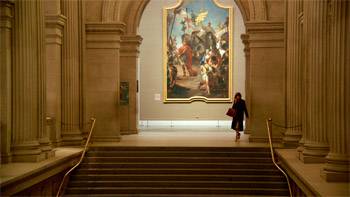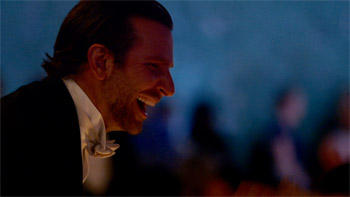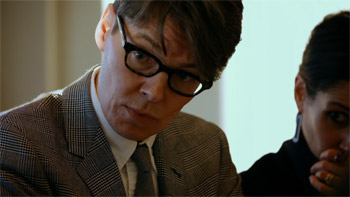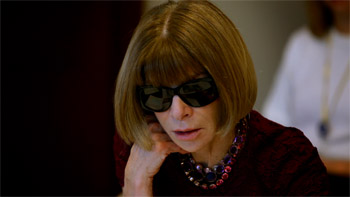Andrew Rossi The First Monday In May

Andrew Rossi The First Monday In May
Featured: Anna Wintour, Andrew Bolton, Baz Lurhmann, Andre Leon Talley, Karl Lagerfeld, Jean Paul Gaultier, John Galliano, Rihanna
Director: Andrew Rossi
Genre: Documentary
Rated: M
Running Time: 91 minutes
Synopsis: An unprecedented look behind the scenes of two of New York's premier cultural events, The First Monday in May follows the creation of 'China: Through The Looking Glass," the most attended fashion exhibition in the history of The Costume Institute at The Metropolitan Museum of Art, and the 2015 Met Gala, the star-studded fundraiser that celebrates the opening of the exhibition. Acclaimed filmmaker Andrew Rossi (Page One: Inside the New York Times) follows Anna Wintour, Artistic Director of Condé Nast and editor-in-chief of Vogue magazine and longtime chair of the Met Gala, and Andrew Bolton, the iconoclastic curator who conceived the groundbreaking show, for eight months as they prepare for an evening they hope will take the worlds of art and fashion by storm.
Documenting one of the most exclusive parties in the world side-by-side with an exhibition that drew more than three-quarters of a million visitors during its four-month run, The First Monday in May is a captivating portrait of the private side of a pair of high-profile public events. The blockbuster exploration of Chinese-inspired Western fashions provides inspiration for the Met Gala's annual collision of haute couture and celebrity, where Hollywood stars including Kate Hudson, George Clooney, Julianne Moore, Jennifer Lawrence, Gong Li, and Lady Gaga rub shoulders with Alicia Keyes, Kim Kardashian, Kanye West, Justin Bieber, Michael Bloomberg and contemporary pop icon Rihanna, who brings down the house with a stunning live performance. 
The First Monday in May also reignites the debate over whether fashion can and should be viewed as art. Rossi speaks with renowned creators including filmmakers Wong Kar-Wai, Artistic Director of the exhibition, and Baz Luhrmann, as well preeminent fashion designers Karl Lagerfeld, Jean Paul Gaultier, Guo Pei and John Galliano. Thomas P. Campbell, Director of The Metropolitan Museum of Art, and Former Curator in Charge of The Costume Institute Harold Koda offer unexpected insights on the relationship between art, craft and commerce.
Relativity Studios & Planted Projects present, in Association with Condé Nast Entertainment, Media Weaver Entertainment and Sarah Arison Productions, a Fabiola Beracasa Beckman Production of an Andrew Rossi Film. The First Monday in May is directed by Andrew Rossi and produced by Fabiola Beracasa Beckman. The film is produced by Sylvana Ward Durrett and Dawn Ostroff. Producers are Matt Weaver and Skot Bright. Executive producers are Sarah Arison, Jason Beckman, Josh Braun, Nancy Chilton, Ryan Kavanaugh and Tucker Tooley. The film is edited by Chad Beck A.C.E, and Andrew Coffman with additional editing by Andrew Rossi. Cinematography is by Andrew Rossi and Bryan Sarkinen with additional cinematography by Andrew Coffman, Alec Jarnagin, S.O.C., Nathan Mauger, Jonathan Furmanski, and Thor Thielow. Original music is by Ian Hultquist and Sofia Hultquist. The film is produced in association with Farfetch.
The First Monday In May
Release Date: May 21st, 2016
About The Production
'Fashion can create a dream, create a fantasy, it's a kind of theater." - Anna Wintour
Each spring, the broad sidewalks and steep stairs of Manhattan's Metropolitan Museum of Art are transformed for an evening, as the throngs of tourists and food carts disappear and, in their place, a glittering catwalk arises filled with some of the world's most recognisable figures in fashion, business and entertainment. The most sought-after invitation in New York City, the Gala finds Academy Award®-winning actors and supermodels sharing the spotlight with pop-music icons and political powerbrokers for an evening unlike any other.
 In his latest film, The First Monday in May, acclaimed documentarian Andrew Rossi captures an unprecedented look behind the scenes of the 2015 Met Gala, and the spectacular exhibition it honors, The Costume Institute's blockbuster exhibition, 'China: Through the Looking Glass." Rossi follows exhibition curator Andrew Bolton and Gala co-chair Anna Wintour during the crucial eight months before the show's debut, as they travel from New York to Paris to Beijing to build support for their audacious endeavor.
In his latest film, The First Monday in May, acclaimed documentarian Andrew Rossi captures an unprecedented look behind the scenes of the 2015 Met Gala, and the spectacular exhibition it honors, The Costume Institute's blockbuster exhibition, 'China: Through the Looking Glass." Rossi follows exhibition curator Andrew Bolton and Gala co-chair Anna Wintour during the crucial eight months before the show's debut, as they travel from New York to Paris to Beijing to build support for their audacious endeavor. With 'China: Through the Looking Glass," Andrew Bolton plans to bring contemporary and historical fashion together with fine art, world history and film for one of The Metropolitan Museum of Art's most ambitious projects ever. Wintour's task will be to stage an unforgettable opening gala that reflects the spirit of the show.
Under her patronage, the fundraiser " which provides the main source of funding for The Costume Institute " has grown in spectacle and prestige every year. In the words of former Vogue editor-at-large André Leon Talley, 'Since Anna Wintour has taken over the Met Ball, it has become the Super Bowl of…fashion events."
In a collaboration between The Costume Institute and The Met's renowned Department of Asian Art, Andrew Bolton begins to create a unique portrait of the influence of Chinese aesthetics on Western fashion and the myriad ways in which China has fueled the West's creative imagination at least since the Portuguese established permanent trade in the 16th century. Filling both The Costume Institute and the Chinese Galleries of The Met, the groundbreaking multimedia extravaganza features more than 140 striking examples of haute couture and ready-to-wear fashions set against a backdrop of Chinese paintings, porcelains and other fine art, as well as films depicting the ongoing cultural dialogue between East and West.
Boyish and intense, Andrew Bolton recalls his life as a kid from Lancashire, England, who only learned about fashion though magazines before going to London after graduating college, where he saw fashion confronting social issues for the first time. His position at The Costume Institute, he says, is his dream job. Now he is using his uncanny abilities as a master storyteller and showman to become a transformative figure in fashion history, a discipline he feels has historically not gotten the respect it deserves.
Determined to build on the accomplishments of The Met's phenomenally successful 2011 exhibit 'Alexander McQueen: Savage Beauty," Andrew Bolton began planning an immersive and theatrical presentation meant to provoke controversy as well as evoke the romance, mystery and exoticism associated with China.
'Some people have a very 19th-century idea of what art is," Andrew Bolton says. 'There are people within the museum who still dismiss fashion. -Savage Beauty' was a turning point in how art critics began to view fashion. For the first time, they did begin to see it as an art form."
The First Monday in May began production in July of 2014, after Andrew Rossi was invited to meet with Vogue's Director of Special Projects Sylvana Ward Durrett, and then with Anna Wintour herself, about directing a film that would document the exhibit and the Gala.
'They were fans of one of my earlier films, Page One," he notes. 'I threw my hat in the ring as someone who might want to work on this film. After meeting with Met Director Tom Campbell and Andrew Bolton, they called me back and we started shooting. I filmed a preliminary meeting between Anna Wintour, Andrew Bolton and the exhibition's artistic director, filmmaker Wong Kar-Wai, and it just sort of took off from there."
As Andrew Bolton's bold concept for the show begins to take shape, he proposes an unconventional setting that will reconfigure The Met's Asian galleries and use selections from the museum's own Chinese collection to provide context for the show, a suggestion that sets off a politically charged debate with curators of the museum's Department of Asian Art.
'Andrew Bolton and Harold Koda really strike at the core of the question, -what is art?'" says Andrew Rossi. 'The answer pivots to a large degree on what we consider to be a -product,' something made for commercial purposes, versus something that is made for its own sake."
Andrew Bolton and his team's concept for the show includes a glowing 'bamboo forest" made of dozens of Plexiglas poles, blue and white porcelains sitting next to formal dresses inspired by age-old patterns, antique vases mingled with pieces by Yves Saint Laurent, Tom Ford and early 20th-century couturier Paul Poiret, and Mao jackets juxtaposed with Warhol portraits " all graphic demonstrations of Andrew Bolton's assertion that the creative process in fashion can be equivalent to the work of a fine artist.
The result is a breathtaking exploration of the line between inspiration and appropriation, imagination and authenticity. '-China: Through The Looking Glass' presents a fascinating context in which to see that fashion is not just about making clothes," says Andrew Rossi. 'We see how designers interpret Chinese visual symbols to create a fantasy version of Chinese iconography, which they freely manipulate in terms of the fabrics chosen, silhouettes created, visual motifs employed and more. The designers take an idea about Chinese culture and transform it into an original work."
'Orientalism," or the outsider's view of Eastern culture, is also central to Andrew Bolton's creation, reinforced by stereotypical depictions of China in American movies of the 1920s '30s and '40s. Throughout the exhibition, spectral projections of clips from classic film including The Last Emperor, Raise the Red Lantern and Wong Kar-Wai's In the Mood for Love remind museumgoers that the West's vision of the ancient empire as a fantasy world peopled by 'Dragon Ladies" and 'Lotus Blossoms" ignores the complexities of a sophisticated and often misunderstood culture.
Andrew Rossi follows Andrew Bolton to Paris, where he visits the hermetically sealed vaults of the Saint Laurent archives to view the designer's China-inspired 1977 Fall/Winter collection and talks to Maison Margiela's creative director John Galliano about the culture's influence on his work. Traveling on to Beijing, Bolton and Wintour contend with modern China's sensitive self image and assure journalists, politicians, businesspeople and other potential supporters that the exhibition will be more than 'just dragons and Ming vases," as one interviewer says.
Also in Beijing, they visit the atelier of leading Chinese designer Guo Pei, who lends several extraordinary pieces to the show. Guo concentrates on reclaiming and updating the honored traditional crafts of China in her work, describing one garment she creates as 'a wedding dress for my country."
 As the opening approaches, Anna Wintour personally vets every detail of the gala from table linens to seating charts. 'As Harold Koda explains in the movie, Anna has figured out that the marriage of celebrity and haute couture is greater than the sum of its parts," says Andrew Rossi. 'When you see Rihanna in a couture gown on the red carpet, it's transcendent, just a visual feast that people who love fashion and media find really satisfying as a visual spectacle and as a glimpse of celebrity culture on steroids."
As the opening approaches, Anna Wintour personally vets every detail of the gala from table linens to seating charts. 'As Harold Koda explains in the movie, Anna has figured out that the marriage of celebrity and haute couture is greater than the sum of its parts," says Andrew Rossi. 'When you see Rihanna in a couture gown on the red carpet, it's transcendent, just a visual feast that people who love fashion and media find really satisfying as a visual spectacle and as a glimpse of celebrity culture on steroids." Given access to the formidable editor in her Vogue offices, at The Met and even at home, Andrew Rossi says he wanted to discover something new about a public figure who has been written about extensively and who is singularly adept at managing her image. 'I admit that when I went to meet her for the first time, all the stories and media coverage surrounding her gave me a slight sense of trepidation," he says. 'I wanted to unpack that in the film as well and create a verité portrait of her that, to a degree, penetrates the Anna Wintour mythology."
At that first meeting, Anna Wintour warned the director to expect significant challenges while filming at The Met, because of the difficulty of navigating around the priceless artwork on display. 'But she was very personable, forthright and clear," he says. 'She was not the character that gets bandied about in the media. Yes, she is a very exacting boss, and she does not shy away from conflict. We see that very emphatically in the film. But she is committed to providing the support to Andrew Bolton and the curatorial staff that can help them to achieve their goals."
At the museum, the heavy lifting begins weeks before the exhibition debuts, with elaborate garments painstakingly unpacked and inspected, galleries reconfigured. Just prior to the gala, legions of youthful Vogue staffers are deployed to rehearse for the big night. When the first guests enter through a tunnel lined with cinematic references, Andrew Rossi follows Michael Kors and his muse for the evening, Kate Hudson, through the experience.
'We wanted to give viewers the opportunity to see the show through the eyes of the attendees at the Gala," he says. 'Condé Nast was crucial in terms of being able to get access to the gala itself and coordinating filming with Michael and Kate, who were sort of our guides through the exhibition."
The 2015 event attracted such luminaries as Jennifer Lawrence, Anne Hathaway, Jessica Chastain, Lady Gaga, Kendall Jenner, Julianne Moore, Kate Hudson, and perhaps most memorably, Grammy®-winning R&B superstar Rihanna in a show-stopping, imperial yellow, fur-trimmed, embroidered cape by Chinese designer Guo Pei that reportedly took thousands of hours to construct.
After a seated dinner inside the American Wing alongside the Temple of Dendur, with Wintour and Bolton flanked by the likes of George and Amal Clooney and Bradley Cooper, the crowd is treated to a spectacular performance by Rihanna. 'In the film, the Gala is not only a celebrity-rich visual environment, but also the culmination of all the hard work we've been watching Andrew Bolton do throughout the year to put together the show," says Rossi.
Like Rossi's previous films Page One, a look behind the scenes at the New York Times, and Ivory Tower, an examination of what he calls 'the higher education industrial complex," The First Monday in May is an expression of his keen interest in exploring the missions of large institutions though the individuals who build and run them.
'I have gone behind the scenes of organisations that seem impenetrable from the outside to try and understand what earns them such a vaunted role in our society," Andrew Rossi says. 'I look at whether or not that position is warranted through the humanity of someone who represents the organisation. So when I had the opportunity to go inside The Metropolitan Museum of Art, one of the most impressive cultural institutions in the world, I wanted to understand why we have museums, what their functions are and how we decide what qualifies as the -art' entitled to be housed inside their hallowed walls."
The First Monday in May showcases an extraordinary intersection of scholarship and stardom. 'It's about the art of fashion, as well as the visual pleasure that we as an audience get in the celebrity spectacle on view at the Met Gala," says Andrew Rossi. 'But it also tries to understand the mechanics of how art and commerce converge in The Costume Institute each year. I hope that the analytical context we get from hearing the curators explain their mission combined with the actual visuals of the costumes and gowns will help viewers see fashion in a new light. Clothes and fashion are ubiquitous now on social media and all over the Internet. It's so easy to take it for granted. It's nice to be able to slow things down here and really take it in."
The First Monday In May
Release Date: May 21st, 2016
MORE





